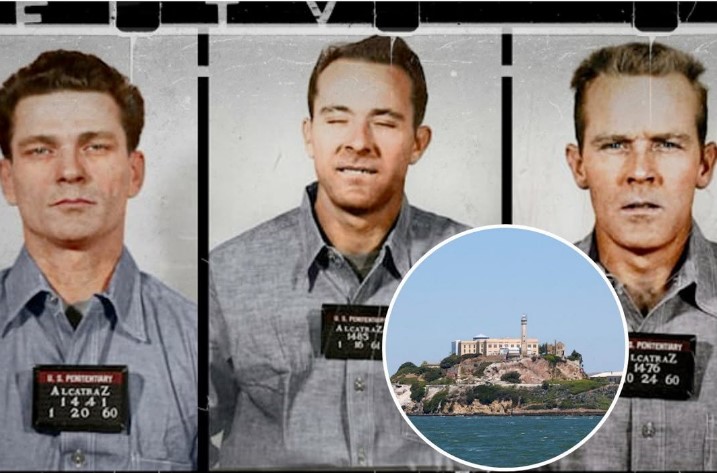The Alcatraz Mystery Finally Cracked: After 55 Years, The Truth Emerges
The night of June 11, 1962, was black, cold, and unnervingly still — perfect for a desperate gamble. Three inmates slipped from their cells into the shadows of America’s most feared prison, vanishing into the frigid waters of San Francisco Bay. Their disappearance would ignite one of the most enduring mysteries in U.S. criminal history.
For decades, the fate of Frank Morris and brothers John and Clarence Anglin baffled investigators and fascinated the public. Were they drowned by the icy current, or did they pull off the impossible and live to tell the tale? After half a century of speculation, new evidence may have finally revealed the truth — and shattered the myth that Alcatraz was escape-proof.
The Rock That Couldn’t Be Broken

Alcatraz, the “Rock,” was built to extinguish hope. Rising from the middle of the bay, it was ringed by treacherous waters, bone-chilling temperatures, and powerful tides that could sweep away even the strongest swimmer. From 1934 to 1963, it held some of America’s most dangerous criminals — from Al Capone to George “Machine Gun” Kelly — and prided itself on being utterly escape-proof.
In nearly three decades of operation, 36 men tried to flee. All but three were either captured, shot, or presumed drowned. The last group — Morris and the Anglin brothers — became legend.
The Ingenious Plan
Frank Morris, a brilliant but hardened inmate, was known for his exceptional IQ and ability to outthink authority. Teaming up with the Anglin brothers — experienced bank robbers and craftsmen — he spent months designing an escape that would exploit every overlooked detail of prison life.
Using spoons, a drill fashioned from a vacuum cleaner motor, and scrap materials from the prison workshop, they dug through the ventilation shafts behind their cells. They concealed the holes with cardboard painted to match the walls, and at night, they worked by the muffled rhythm of their tools.
To buy time after the escape, they created dummy heads out of soap, toilet paper, and human hair taken from the prison barber shop — eerily lifelike enough to fool guards during bed checks.
Their most audacious innovation, however, was a raft built from 50 raincoats, sewn together and sealed with heat from prison pipes. On that June night, they slipped through the holes, climbed up to the roof, and disappeared into the bay.
By morning, the alarm sounded. The guards found the fake heads, the widened vents, and the evidence of the raft’s construction. Within hours, helicopters and patrol boats scoured the area — but the men were gone.
The official conclusion was grim: they drowned. Yet no bodies were ever recovered.
A Case That Refused to Die

The FBI investigation, one of the most extensive in its history, consumed resources for years. Coast Guard searches, interviews with relatives, and surveillance of the Anglin family produced nothing concrete.
When the FBI closed the case in 1979, the agency declared the men dead. But not everyone agreed. Retired U.S. Marshals and private investigators kept digging, following faint trails that led from the Florida Keys to South America. Rumors of the brothers’ survival became modern folklore.
The Letter That Reopened Everything
In 2013, a startling twist reignited the cold case. The San Francisco Police Department received an anonymous letter claiming to be from John Anglin. In it, the writer confessed that he, Clarence, and Frank Morris had survived the escape, lived under new identities, and were now elderly and ill.
“Yes, we all made it that night,” the letter read. “We made it to safety… but I’m sick now. I have cancer. If you announce on TV that I’ll be promised medical help, I’ll tell you where I am.”
Forensic testing on the letter’s handwriting and DNA was inconclusive — neither verified nor disproved. Still, the details matched facts that only the escapees would have known. The possibility that the Anglins were alive suddenly seemed less far-fetched.
The Photograph That Stunned Investigators

In 2018, a new piece of evidence reignited worldwide interest. A photograph allegedly taken in Brazil in 1975 surfaced, showing two men — middle-aged, tan, and standing side by side on a rural farm. When analyzed using AI facial recognition software by Rothco and Ident TV, the results shocked investigators: the faces were an extremely close match to John and Clarence Anglin.
While skeptics pointed out the limitations of AI image comparison, the statistical probability was too high to ignore. Combined with the letter, the raft fragments found on Angel Island, and tidal studies proving a successful crossing was possible, the balance of evidence began to tip.
Could the three men have survived — and lived quietly for decades?
The Human Side of the Legend
In interviews, relatives of the Anglin brothers have long hinted at survival. Family members recalled receiving unsigned Christmas cards and postcards from abroad, some written in handwriting identical to the brothers’. A photograph sent anonymously to the family in the 1980s depicted two men resembling the Anglins standing near a car — once again, in Brazil.
Even former U.S. Marshals assigned to the case have admitted that they never completely believed the men had drowned. “There’s always been that 1 percent chance,” one investigator said. “Now, maybe it’s closer to 50.”
What the Evidence Suggests
Pieced together, the clues form a compelling timeline:
-
The raft was found intact near Angel Island, indicating the men successfully made landfall.
-
Weather and current data from that night show a narrow window of favorable tides.
-
The 2013 letter reveals insider knowledge of the prison’s interior.
-
The 1975 Brazil photograph, now AI-verified, adds visual corroboration.
If authentic, it means the escape was not just successful — it was flawless. The men vanished into a new life, aided possibly by organized crime contacts or sympathizers. They would have been in their 40s when they disappeared and could have lived decades abroad, far from American jurisdiction.
The Legacy of the Impossible
The Alcatraz escape has come to represent more than just a crime. It’s a testament to the human drive for freedom — the willingness to risk everything against impossible odds. It inspired films like Escape from Alcatraz, countless books, and decades of speculation.
But the new revelations blur the line between myth and truth. Were they dangerous fugitives who cheated justice — or symbols of determination against oppression?
What remains undeniable is the genius of their plan: built with nothing more than stolen tools, cunning, and unbreakable resolve.
The Unanswered Question
Did Frank Morris and the Anglin brothers really live out their days in Brazil, their secret known only to each other? Did they die peacefully, far from the Rock that once caged them?
We may never know for certain. But after 55 years, the evidence points toward one extraordinary truth: Alcatraz may not have been unbreakable after all.
The world’s most famous prison break — once written off as a failure — now stands as a testament to human ingenuity and endurance.
And somewhere, beneath the endless speculation and mythmaking, lies a single, haunting possibility: they got away with it.
Sources:
National Geographic – The Real Story of the Alcatraz Escape
FBI Archives – Alcatraz Escape Investigation Summary
Smithsonian Magazine – New Evidence in the Alcatraz Case
CNN – Letter Claiming Survival Reopens Alcatraz Mystery
The Guardian – Alcatraz Escape: The Mystery That Still Haunts the Bay
